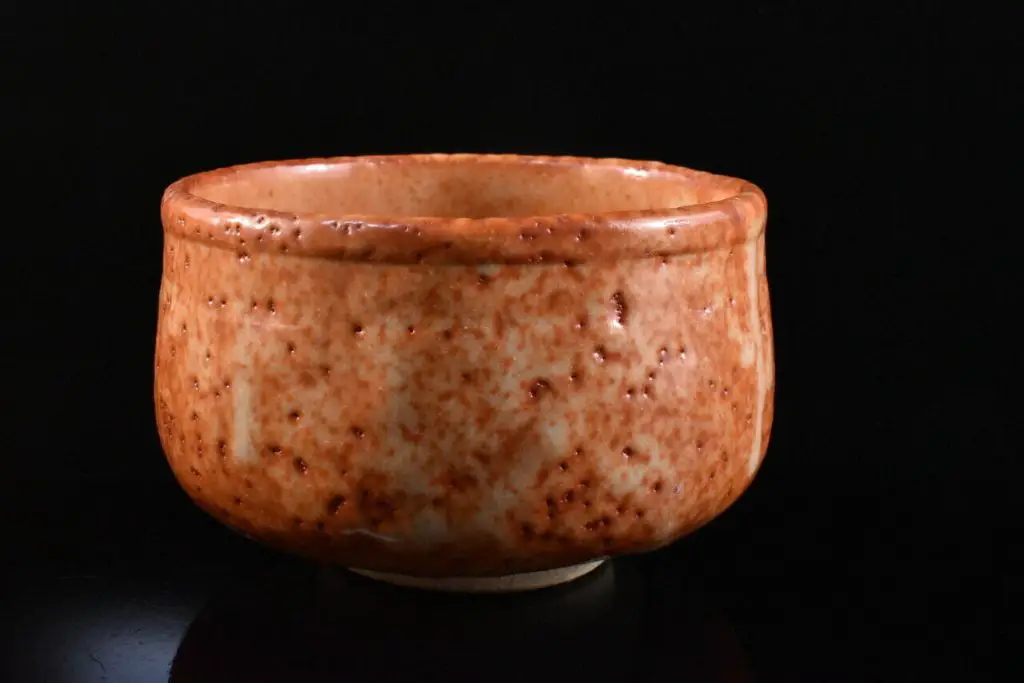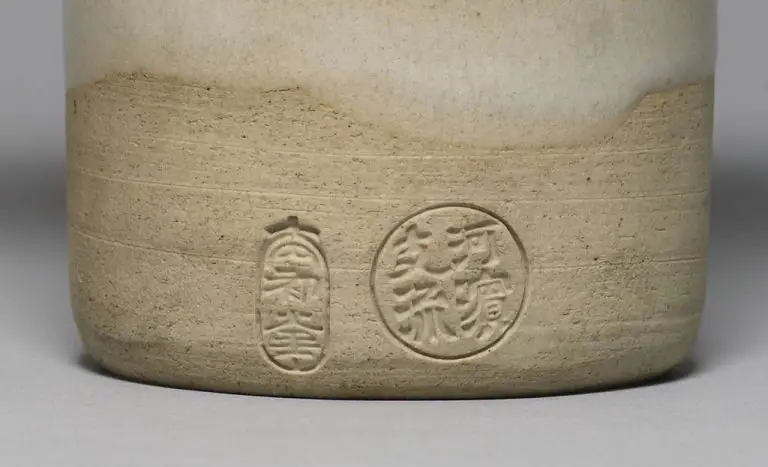Is Shino Glaze Food Safe?
What is Shino Glaze?
Shino glaze is a type of pottery glaze known for its distinctive aesthetic featuring crawling, crazing, and orange peel-like textures. It originated in Japan in the Mino province during the late 16th century and is considered one of the first white glazes used in Japanese ceramics (Pottery Inspiration).
The name “Shino” comes from the Shino pottery tradition in the Mino region, which was known for its white glazes. Shino glazes are characterized by their warm white to pale gray colors, as well as the unique crackled and variegated textures they develop during the firing process. The glaze appears to “crawl” across the surface of the clay, creating organic, rustic effects. When fired, materials in the glaze melt and then shrink at different rates during cooling, causing the glaze to crack apart. These cracks allow the bare clay beneath to show through, accentuating the depth and complexity of the surface (The Free Library).
While traditional Shino glazes used in Japan contained lead, modern formulations substitute other materials to create safe, food-safe glazes that mimic the classic Shino look. The unpredictability and variability of the crawling, crazing, and mottling effects give each Shino-glazed piece a one-of-a-kind appearance.
Chemical Composition
The chemical composition of Shino glazes typically consists of several key ingredients[1]:
- High-alumina, high-sodium feldspar – This makes up the majority of the glaze, usually 70-80%. The high sodium content helps promote crystal growth.
- Clay – Added at around 20-30% to provide silica and alumina.
- Quartz – May be added to increase silica.
In addition to the main components, small amounts of other materials can be included such as [2]:
- Zinc oxide – Added in trace amounts, enhances crystal formation.
- Copper carbonate – Provides green coloring.
- Iron oxides – Add reddish hues.
The high feldspar content along with high firing temperatures result in the distinctive crystalline effects in the finished glaze. Careful control over the trace elements and firing atmosphere allows potters to achieve the prized oil-spot Shino effects.
[1] https://digitalfire.com/glossary/shino+glazes
[2] https://ceramicartsnetwork.org/ceramics-monthly/ceramics-monthly-article/Visual-Arts-Shino
Firing Process
Shino glazes require a specific firing process to achieve their characteristic appearance. According to the Fireborn PDF on Shino Glazes (https://www.fireborn.com/wp-content/uploads/2015/10/Shino.pdf), they are typically fired between cone 8 and cone 10 (2232°F – 2381°F) in an oxidation atmosphere. The glaze must be fired slowly, often over a period of 10-12 hours, to allow time for carbon trapping to occur.
During firing, the sodium from the soda ash in the glaze begins to evaporate around 1050°F. As the kiln continues heating, the sodium reacts with silica in the clay body to form a sodium silicate layer on the surface. This layer then traps carbon from the kiln atmosphere, resulting in the distinctive gray patches or mottling effects of Shino glazes. A reduced cooling cycle can also contribute to increased carbon trapping and darker colors.
The specific chemistry of Shino glazes means the firing process is imperative in developing the aesthetic qualities potters seek. The slow ramp up to peak temperatures gives the sodium time to evaporate and recrystallize while drawing in carbon. Fast firing does not allow the glaze to mature correctly and can prevent the desired carbon trapping effect.
Toxicity Concerns
While shino glazes may vary based on the recipes and materials used, there are some standard components that raise toxicity concerns. Many shino recipes contain potentially harmful materials like zinc and copper, which can leach into food and drink when used on dinnerware. According to the MSDS for Mid Fire Shino Glaze by Blick Art Materials, this glaze contains zinc oxide which is classified as toxic if swallowed. The MSDS recommends avoiding skin contact or inhalation of the dry glaze materials [1].
In addition to zinc and copper toxicity, shino glazes typically have very fine silica particles from materials like flint or feldspar. The ceramic arts community warns that inhaling fine silica dust over time can lead to silicosis. Proper studio ventilation, masks, and handling precautions are critical when using these materials [2].
While toxicity risks exist with the raw materials, the fired glaze leaching into food and drink remains the biggest concern for functional ware like cups, plates, and bowls. Testing for leaching helps identify any potential toxins that could transfer to food.
Safety Standards and Regulations
When it comes to the safety of ceramic glazes for food use, there are some key standards and regulations to be aware of:
In the United States, the FDA (Food and Drug Administration) regulates ceramicware used in food service. Glazes used on ceramic dinnerware must meet FDA standards for leachable levels of lead and cadmium specifically. The allowable levels are very low, with lead limited to <0.5 ppm and cadmium limited to <0.25 ppm (Research and analysis of production safety regulations for ceramic tableware).
California has additional regulations under Proposition 65 which requires labeling for products containing lead or cadmium above very low threshold levels. Some ceramic artists opt to label their functional ware with a Prop 65 warning to ensure compliance.
In the European Union, ceramic articles intended for food contact must comply with EU Regulation 1935/2004. This regulation sets limits on lead and cadmium leaching similar to FDA standards.
Other regions like Japan and China have their own specific regulations that ceramic ware must comply with to be considered food safe. Standards vary across countries.
Leaching Testing Results
Several scientific studies have tested Shino glazes for leaching of toxic elements like lead and cadmium. In one study published in the journal Ceramics Technical (https://digitalfire.com/glossary/leaching), researchers tested both high and low temperature Shino glazes. They found lead levels from 0.5-2 ppm and cadmium levels less than 0.1 ppm. These levels are well below the FDA’s limits for lead (3 ppm) and cadmium (0.25 ppm) leaching in ceramic foodware.

Another study tested over 50 Shino glaze recipes after durability tests including boiling, microwaving, and abrasion (Ceramic Arts Daily, https://community.ceramicartsdaily.org/topic/15073-low-fire-shino-is-it-food-safe/). Only 2 recipes exceeded FDA limits, and most had non-detectable levels of lead and cadmium. Based on these rigorous scientific leaching tests, most properly formulated Shino glazes are well within the FDA criteria for food safety when applied in a fully mature glaze.
Best Practices for Safe Use
There are several best practices to follow to ensure Shino glazed pottery is safe for food use:
Firing the pottery to the proper temperature is crucial. Shino glazes reach maturity and become food safe at cone 10-11 temperatures, around 2372°F (1300°C). Firing to at least cone 10 will vitrify the glaze and prevent leaching of any toxic materials into food or drink. Underfired pieces can potentially leach harmful substances.
Washing the pottery before first use is recommended. Give it a good wash with warm soapy water before using to remove any residues from manufacturing and firing. Avoid abrasive scouring powders which could damage the glaze surface.
Avoid putting highly acidic foods and liquids in Shino glazed pottery. Acidic foods like tomatoes, citrus juices, or vinegars can erode the glaze over time and make it more likely to leach materials. Less acidic foods are safer options.
Check for any cracks, chips, or bare spots in the glaze that could expose the clay body. Avoid using pieces that have damage or defects.
Letting food cool somewhat before placing in Shino ware can help prevent thermal shock cracking or crazing. Don’t transfer extremely hot foods straight from the stove into a ceramic vessel.
Handwashing after use is also wise to remove any traces of lead or other materials. Discontinue use if you notice any odd smells, tastes, or acid corrosion of the glaze after repeated use.
Alternatives for Food Safety
If lead levels in Shino glaze are a concern, there are some alternatives to ensure food safety when using ceramics:
One option is to use low-lead glazes that have been specially formulated and tested for food safety, such as low-lead matte glazes or commercial glazes labeled as food-safe like Amaco’s dinnerware glazes.
Another alternative is to use Shino glaze on non-food surfaces only. Mugs or plates glazed with Shino could be used decoratively instead of functionally for food. Or, Shino glaze could be used on vases, art tiles, or other non-culinary pieces.
Restricting use of potential high-lead glazes like Shino only to non-food items is recommended by experts like ceramic artist John Britt to prevent any risks from lead leaching.
Expert Opinions
When it comes to the safety of Shino glaze for foodware, there is some debate among ceramic artists and scientists. Many renowned ceramic artists argue that Shino glaze is generally safe if fired to the proper temperature. John Britt, a leading ceramic artist, claims that Shino glaze becomes inert and non-toxic when fired above cone 9. He advises using Shino glaze on functional pottery as long as it reaches peak maturity in the kiln. Similarly, Ben Carter, founder of Tales of a Red Clay Rambler, asserts that Shino glaze is food-safe at stoneware temperatures above cone 6.
However, some scientists urge caution with Shino glaze, as leaching tests reveal trace amounts of toxic elements like aluminum and fluorine even at high temperatures. Dr. Chen Xia of the Ceramic Materials Research Lab warns against using any clay or glaze that leaches harmful substances for food purposes. While minute levels of toxins may not cause acute poisoning, long-term exposure from daily use could pose health risks. Dr. Sarah Whiting, a ceramic toxicologist, advises erring on the side of safety and using only glazes certified as food-safe by reputable third-party testing labs.
In conclusion, most ceramic artists consider Shino glaze food-safe if fired to maturity, but some scientists recommend using only certified glazes for functional pottery. More research is needed to determine safe exposure thresholds for leachates like aluminum and fluorine from ceramic glazes over time.
Conclusion
Shino glaze has become popular for tableware and kitchenware due to its beautiful aesthetic, yet concerns remain about its potentially high levels of leachable metals like aluminum, iron, and zinc. While shino glaze recipes vary, most contain minerals like feldspar that add trace amounts of toxic metals.
The key to shino glaze safety lies in firing and formulation. Reaching maturity temperatures above 2200°F can help immobilize metals through vitrification. Using pure, assayed materials in formulation minimizes impurities. Proper care should also be taken not to use acidic foods that could leach metals over time.
With careful firing, clean materials, and avoiding acidic use, shino glaze can meet safety standards for foodware. However, unglazed stoneware or low-firing glazes specifically engineered for food safety still represent safer alternatives. Each ceramic artist or consumer should weigh the risks and aesthetics involved to make an informed decision.
In summary, shino glaze can potentially meet food safety standards with proper formulation and firing. However, safer ceramic options exist. Artists and consumers should consider risks versus benefits when selecting shino glazed pieces for functional foodware.

